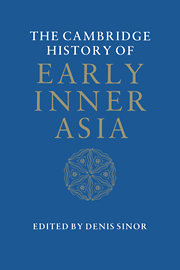Book contents
- Frontmatter
- 1 Introduction: the concept of Inner Asia
- 2 The geographic setting
- 3 Inner Asia at the dawn of history
- 4 The Scythians and Sarmatians
- 5 The Hsiung-nu
- 6 Indo-Europeans in Inner Asia
- 7 The Hun period
- 8 The Avars
- 9 The peoples of the Russian forest belt
- 10 The peoples of the south Russian steppes
- 11 The establishment and dissolution of the Türk empire
- 12 The Uighurs
- 13 The Karakhanids and early Islam
- 14 Early and medieval Tibet
- 15 The forest peoples of Manchuria: Kitans and Jurchens
- Bibliography
- Index
- References
13 - The Karakhanids and early Islam
Published online by Cambridge University Press: 28 March 2008
- Frontmatter
- 1 Introduction: the concept of Inner Asia
- 2 The geographic setting
- 3 Inner Asia at the dawn of history
- 4 The Scythians and Sarmatians
- 5 The Hsiung-nu
- 6 Indo-Europeans in Inner Asia
- 7 The Hun period
- 8 The Avars
- 9 The peoples of the Russian forest belt
- 10 The peoples of the south Russian steppes
- 11 The establishment and dissolution of the Türk empire
- 12 The Uighurs
- 13 The Karakhanids and early Islam
- 14 Early and medieval Tibet
- 15 The forest peoples of Manchuria: Kitans and Jurchens
- Bibliography
- Index
- References
Summary
It has been suggested, with some justice, that a limes system separating steppe from sown, barbarian from cultivated, urban society, spanned Eurasia. This system of fortifications and natural barriers, however, was not impenetrable. When the societies sheltered by these walls were strong, incursions from the nomadic world beyond were repulsed or contained. When their defences proved inadequate, sedentary societies either had to tame the “barbarian” by converting him to their culture or be completely transformed themselves. Western Central Asia, an Eastern Iranian area increasingly coming under the cultural influence of neighboring, kindred Sassanid Iran before the advent of Islam and the recipient of cultural currents emanating from the Mediterranean, India and China, was one of those zones through which the steppe-dweller could enter sedentary society. Conversely, its mercantile urban centers also served as a gateway through which the cultural and material achievements of settled society could penetrate the steppe. In the period under discussion, Western Central Asia, having recently accommodated itself to the political and cultural buffetings administered to it by expanding Arab power, was about to enter into another period of intense and intimate contact with the nomadic, Turkic societies to its north and north-east. In this instance, it would serve as the transmission zone for the cultural fruits of one nomadic society to another. Its role in this process was not passive, for the Islamic culture which entered the steppe zone had been influenced and reworked by the Eastern Iranians.
- Type
- Chapter
- Information
- The Cambridge History of Early Inner Asia , pp. 343 - 370Publisher: Cambridge University PressPrint publication year: 1990
References
- 17
- Cited by



